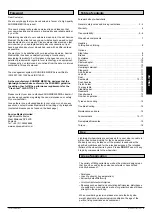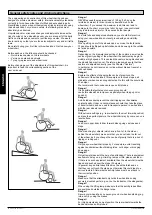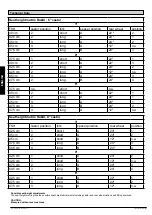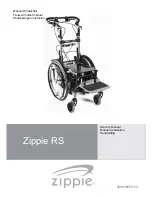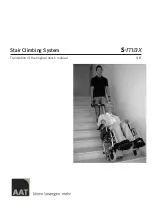
Wheel locks
Your wheelchair is equipped with
two wheel locks. They are applied
directly against the tyres. To
engage, press both brake levers
forward against the stops. To
release the locks, pull the levers
back to their original positions.
Braking power will decrease with:
• Worn tyre tread
• Tyre pressure that is too low
• Wet tyres
• Improperly adjusted wheel locks
The wheel locks have not been
designed to be used as brakes for
a moving wheelchair. The wheel
locks should therefore never be
used to brake a moving
wheelchair. Always use the hand-
rims for braking. Make sure that
the gap between the tyres and
wheel locks complies with given
specifications. To readjust, loosen
the screw (1) and set the
appropriate gap. Then re-tighten
the screw (Fig. 5 + 6)).
CAUTION:
After each adjustment of the rear wheels, check the wheel lock
gap and readjust if necessary.
ENGLISH
BasiX, RubiX, RubiX XL Rev. 1
8
Handling
0806/1/ST-000690646.EMS
Folding up
First remove the seat cushion and the
back seat shell (only on Comfort
Version) from the wheelchair and flip
up the (platform) footplate or the
individual footrests. Take hold of the
sling or the seat tubes in the middle,
from the back and pull upwards. The
wheelchair will then fold up. To fold
your wheelchair so that it is as small
as possible, e.g., to put into a car, you
can remove the footrests (depending
on the model). For this purpose, open
the latch from the outside and swing
the footrest to the side. Then the
footrest only has to be drawn out of
the receiver tube (Fig. 1).
Unfolding
Press down on the seat tube (see
figure). Your wheelchair is then
unfolded. Now snap the seat tubing
into position in the seat saddle. This
can be facilitated by slightly tipping
your wheelchair, as this means that
the weight is taken off one of the rear wheels.
Be careful not to get
your fingers caught in the cross-tube assembly
. Refit the seat
and the back seat shell (Fig. 2).
CAUTION:
Make sure that the back seat shell is clicked in place correctly.
Options - Brakes
Quick-release axles on rear wheel
The rear wheels are equipped with
quick-release axles. The wheels can
thus be fitted or removed without
using tools. To remove a wheel,
simply depress the quick-release
button on the axle (1) and pull the
wheel off the axle (Fig. 3).
CAUTION:
Hold the quick-release button on
the axle depressed when inserting
the axle into the frame to mount the rear wheels. Release the
button to lock the wheel in place. The quick-release button
should snap back to its original position.
Options – Step Tubes
Step Tubes
Tipping tubes are used by
attendants to tip a wheelchair over
an obstacle Simply step on the
tube to push a wheelchair, for
example, over a curb or step (Fig.
4).
Brake lever extension
The extension for the brake lever can be removed or folded down.
The longer lever helps to minimise the effort needed to set the
wheel locks (Fig.7).
CAUTION:
Mounting the wheel lock too close toward the wheel will result
in a higher effort to operate. This
might cause the brake lever
extension to break!
Leaning onto the brake lever
extension while transferring will
cause the lever to break!
Splashing water from tyres
might cause the wheel lock to
malfunction.
Drum brakes
Drum brakes permit safe and
convenient braking for an
attendant. They can also be set
with the aid of a locking lever (1) to
prevent rolling. The lever must
snap audibly into place. Drum
brakes are not influenced by air
pressure inside the tyres. Your
wheelchair cannot be moved when
the drum brakes are set (Fig.8).
CAUTION:
Drum brakes must only be adjusted by authorised dealers.
1
3 mm
1
Fig. 1
Fig. 2
Fig. 3
Fig. 5
Fig. 6
Fig. 4
Fig. 7
Fig. 8
Getting into your wheelchair independently
• The wheelchair should be pushed up against
a wall or solid piece of furniture;
• The brakes should be on;
• The footplates should be hinged up;
• The user can then lower himself into the chair;
• The footplates should then be pushed down
and the feet rested on them in front of the
heel loops.
Getting out of your wheelchair
independently (Fig. 10)
• The brakes should be on;
• The hinged footplates should be hinged up;
• With one hand on each armrest, the person
should bend slightly forward to bring the
body weight to the front of the seat, and with
both feet firmly on the ground, one foot well
back, push up into the upright position.
When standing, do not stand on the footplates or the
wheelchair will tip up. It is easier and safer to get into
your wheel chair if you turn the footplates up and out
of the way or take them off the
wheelchair.
Summary of Contents for Breezy BasiX
Page 2: ......
Page 20: ...19 BasiX RubiX RubiX XL Rev 1 0707 1 ST 000690646 EMS ...
Page 38: ...37 BasiX RubiX RubiX XL Rev 1 0707 1 ST 000690646 EMS ...
Page 56: ...55 BasiX RubiX RubiX XL Rev 1 0707 1 ST 000690646 EMS ...
Page 74: ...73 BasiX RubiX RubiX XL Rev 1 0707 1 ST 000690646 EMS ...
Page 92: ...91 BasiX RubiX RubiX XL Rev 1 0707 1 ST 000690646 EMS ...
Page 110: ...109 BasiX RubiX RubiX XL Rev 1 0707 1 ST 000690646 EMS ...
Page 128: ...127 BasiX RubiX RubiX XL Rev 1 0707 1 ST 000690646 EMS ...
Page 146: ...145 BasiX RubiX RubiX XL Rev 1 0707 1 ST 000690646 EMS ...
Page 164: ...163 BasiX RubiX RubiX XL Rev 1 0707 1 ST 000690646 EMS ...
Page 182: ...181 BasiX RubiX RubiX XL Rev 1 0707 1 ST 000690646 EMS ...
Page 200: ...199 BasiX RubiX RubiX XL Rev 1 0707 1 ST 000690646 EMS ...
Page 218: ...217 BasiX RubiX RubiX XL Rev 1 0707 1 ST 000690646 EMS ...



